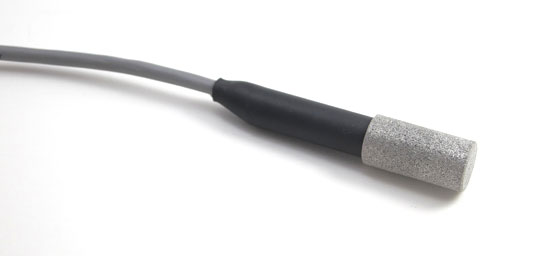TRH-100 Technical Information

TRH-100 Temperature & RH Probe
This page is for customers interested in using the TRH-100 Probe with third-party data acquisition equipment. This page can be ignored if using the TRH-100 with a Pace Data Logger.
The TRH-100 Probe requires 5 vdc excitation at 2 ma max.
Warm-up time (the time from when 5 vdc power is applied until the humidity output signal is stable) is 100 ms.
The probe has four 24 awg insulated leads.
TRH-100 Lead Functions
| Black | Signal return (ground) |
| White | 5 vdc power |
| Green | Humidity output signal |
| Red (or Yellow) | 30k ohm Thermistor |
CAUTION! The TRH-100 Probe's power lead is not reverse polarity protected. Pace Data Logger's provide current limited power to the TRH-100. If the probe will not be used with a Pace data logger, carefully check your connections before applying power.
RH Output Signal
The % Relative Humidity output signal is approximately 0.9 vdc at 0 % RH and 3.9 vdc at 100 % RH. Each TRH-100 probe ships with individual scaling values typed on a durable label bonded to the probe's cable. The scaling values are valid for a 0-5v input channel. Convert the output voltage into % RH using these linear scaling values for ±3% RH accuracy from 0-95% RH. Two sets of scaling values are listed on the label, one for the XR450 (High and Low), and one for the XR5-SE (Slope and Offset).
XR450 scaling values: The first number is a negative value and represents the equivalent % RH at 0 V, the second number represents the equivalent % RH at 5 V. Since the probe's output over its range of 0-100 % RH is from about 1 V to 4 V, scaling for a 0-5 V input range result in the first scaling value being a negative value, and the second number being above 100.
Method 1: Converting the TRH-100's output voltage to %RH using its XR450 scaling values (Low value, High value)
Use the following formula where:
Vout = output voltage of TRH-100 (green wire)
%RH = (Vout / 5) * (High value - Low value) + Low Value
Example:
TRH-100's output reads 3.1 V, Low Value = -33.33, High Value = 133.33
%RH = (3.1 / 5) * (133.33 - (-33.33)) + -33.33 = (0.62 * 166.66) + -33.33 = 103.33 + -33.33 = 70.0
Method 2: Converting the TRH-100's output voltage to %RH using its XR5-SE Slope and Offset scaling values
Use the following formula where:
Vout = output voltage of the TRH-100 (green wire)
%RH = (Slope * Vout) + Offset
Example:
TRH-100's scaling values: Slope = 33.0 Offset = -29.2, TRH-100's output = 2.9 V
%RH = (33.0 * 2.9) + (-29.2) = 66.5
TRH-100's Temperature Signal
The Thermistor output signal is a resistance which varies precisely with temperature. A resistance vs temperature table for this thermistor is found in the file 'C.rvt' which can be downloaded and unzipped here. The same file is also used by Pocket Logger Software (XR450) and LogXR Software (XR5-SE) to calculate temperature based on the measured resistance of the temperature sensor (thermistor). The C.rvt table is in whole degree C increments. For best accuracy, a linear interpolation of the calculated resistance should be performed using the two nearest resistance vs temperature pairs in the table.
Temperature Compensation for RH Measurements
If you are not using Pace software, for accurate RH readings over the probe's entire operating temperature range, a temperature compensation formula should be applied to each calculated RH reading. Use the following formula (for exception, see Note below):
RHc = RH/(1.0546 - 0.00216 * T)
Definitions:
RH = % RH (not temperature compensated).
T = Temperature of TRH-100's temperature sensor in deg. C.
RHc = Compensated % RH reading, accurate over the probe's entire operating temperature range.
Note: Compensation is negligible (less than 1 % RH) in typical conditioned environments (example: office or retail spaces).
Installation in Moist Environments
In moist environments, the TRH-100 Probe should be mounted with the stainless steel filter pointing down. This allows any water condensate to drain out and not collect inside the sensor where it could damage the electronic circuitry within the body of the probe.
Probe Recalibration
Recalibration recommended only if required after years of use
XR450 Data Logger (4 channels)
XR5-SE Data Logger (8 channels)
